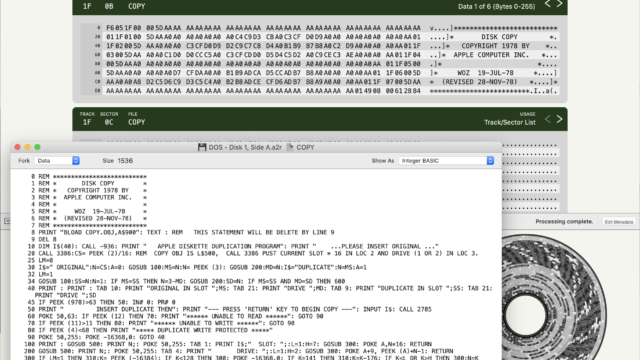The worldwide chip shortage has brought this run of Applesauce units to a close. All complete units are sold out. There are some Upgrade Kits remaining and I have a good supply of the various accessories like sync sensors. Parts suppliers are guessing they may have parts for me again in Q3 2023. As a hobbyist that relies on these sales in order to help pay the bills, this situation is pretty disappointing. I’m going to keep pushing Applesauce forward, because I love doing the work, but progress will slow down a bit.If you are in a position to help support my work, donations via Patreon or Ko-fi are always greatly appreciated. Thanks!
Status Update: Discord, Ko-fi, Patreon, Wiki, and the Chip Shortage
If you check the website looking for new posts here, you have probably noticed that I am terrible at consistently writing posts. The last client release I mention here is 1.50 in October 2021, and we are currently at release 1.60.1. There have been literally been 10 releases since the last update post. Sorry about that. The simple fact of the matter is that I am constantly head down building new features and adding support for more and more disk formats. I currently running a cadence of a new release every 2 weeks and things are evolving at a rapid pace. If you are interested in keeping up with the latest developments about Applesauce, I highly recommend that you join the Applesauce community discord. There is a lot of great conversations going on over there with oodles of technical content if that is your thing. You can join at this link: Join the Discord
I have also started up Ko-fi and Patreon accounts to help me be able to continue spending a good amount of time working on Applesauce. It also helps to fund the purchase of new gear for testing and for reverse engineering disk formats. If you are in a position to be able to help the project financially, it is greatly appreciated! Donate via Ko-fi or Become a Patron
All of the documentation here on the website is being transitioned over to a new wiki that the community is helping to construct. It is still in the early stages, but I am really excited about the plans for it. I think that it is going to become a tremendous reference for Applesauce users as well as users of other disk imaging tools. The wiki can be found here.
Lastly, as of this writing, there is still some Applesauce hardware available. But we are coming down to the end of the production run. Also, the heart of the Applesauce hardware is now completely out of stock at the manufacturer due to the worldwide chip shortage. Once these units I have in stock are sold, we have no idea when new ones will be available. Currently hearing that there may be some availability in July/August 2022, but it is far from being guaranteed. We still have lots of stock of upgrade kits, sync sensors, and other accessories, so we will still be offering those.
Thank you everyone for the continued support of the Applesauce project!
New Applesauce Production Run is Happening Now!

Finally, after a year of waiting, Applesauce units are available once again! The year has proven to be extremely difficult to acquire the parts needed to produce Applesauce. I have been slowly gathering what I needed over the last 7 months or so, but between the worldwide chip shortage and overall chaos due to COVID-19 this has proven to be a challenge. And to add to the complexity, huge price increases and import tariffs have made it much more costly to produce. But, with everything finally in hand I am finally able to get some new units out into the world. There aren’t a lot of them, but hopefully enough to satisfy the current demand.
For this production run there is a completely new set of PCBs that bring with them the ability to use 34-pin PC floppy drives in addition to the Apple II and Mac drives that were supported in earlier revisions of the hardware. This makes Applesauce compatible with a wider range of floppy drives than any other disk imaging solution. For owners of previous revisions, upgrade kits are available. But note that if you don’t need to use PC drives, then there is no real benefit to upgrading. Your current hardware will continue to be supported 100% and will receive all major new features.
There are also new sync sensors available for Shugart-based Disk II drives and the UniDisk 5.25 (A9M0104 and A9M0107).
Each unit takes about 45 minutes to assemble, test, and pack so it isn’t a fast process to fulfill orders. I will be shipping orders out every day, but depending on the order backlog it may take several days to a week to get your order shipped, so please be patient. There is also a pretty lengthy wait list, and wait list orders will be given priority over other orders.
I have been working hard on adding more content and information to the website, so feel free to look around. I’ll be continuing to add more between processing orders.
For those of you hearing about Applesauce for the first time, you can read about what makes Applesauce special on the What is Applesauce? page.
Thanks to all of you for your support of the Applesauce project!
Client Release 1.50
This is a huge new release mainly focused at support for the revision 2 Applesauce hardware, but with lots of new stuff for owners of current hardware. The new hardware adds support for working with drives using the standard 34-pin interface (most PC drives). The A2R format used by Applesauce has also been updated to version 3.0 in this release. Lots of new features in the updated format like support for hard sectored disks. But please note that the new A2R 3.0 files are not readable by older client versions.
Floppy Drive Profiles and Configuration
PC floppy drives can have a wide range of features and different jumper settings. Applesauce helps you get your drives ready for duty by probing the drive to determine its capabilities and help ensure that its settings are correct. And then it will remember all of this information by managing drive profiles for you.
Disk Imaging
Since I needed to be touching the fast and flux imagers, I decided to completely modernize the code for both. And of course this ended up being an almost complete rewrite of both imagers.
- Full support for hard sectored disks when using PC drives.
- Added support for fast and flux imaging of Amiga DD and HD disks.
Disk Analyzer
- Now outputs fewer log messages for things like custom nibble translate tables.
- Lots of new menu commands for manipulating and navigating disk images.
- Support for Amiga disks as well as file system browsing of AmigaDOS disks (both OFS and FFS).
Disk Image Formats
- Added support for loading SCP files. Some tools don’t properly fill out the disk type value in the SCP header, so some images may need to be tweaked in a hex editor before being able to load.
- Added read/write support for Amiga ADF files.
- Added support for TI-99/4 V9T9 disk images.
- Support for IMG files of 1680K (Microsoft DMF) PC disks.
Miscellaneous Fixes and Improvements
- There is a new Sync Sensor Installation Assistant screen available under the Drive menu. This will allow you to test sync sensor functionality and can be a huge help when installing sensors.
- If for some reason your floppy drive isn’t detected by Applesauce, there is a new Override Drive Type command under the Drive menu. But, be careful with this command as it bypasses some Applesauce safety protocols!
- Improved heuristics for Forth Blocks detection and formatting.
- Drive Diagnostics now shows milliamp current loads on +12v and +15v rails separately.
- Improvements to FM decoding of streams with many glitches in them.
Release 1.48
This release has been a long time in the making. I have been quite busy designing the next generation of Applesauce hardware as well as preparing for a new production run. The new revision 2 hardware will add support for 34-pin PC drives, and a lot of the R&D work that goes along with that has been baked into this release. But there is also a ton of new stuff added to the client.
Drive Picker and Configuration
There is a new drive configuration system in place now. It was primarily designed for the upcoming PC-drive support, but also comes in handy for Disk II compatible drives. When the app starts up and locates the Applesauce hardware, it will now ask you to identify the drive that is connect. First time through this, there will be no known drives, so you will need to add one. The configuration screen that comes up can be a bit intimidating, but most of the information is for PC drives, so you are free to ignore it. You should enter the Manufacturer and Model name and then hit the “Check Settings” button. This will have Applesauce check the drive to determine things like how many tracks the drive can reach. You can then hit the “Save & Use” button to get started using the app. The next time you come into the app, the drive entry will be ready and waiting for you to use. Applesauce can automatically recognize Apple 3.5 Drive and SuperDrives, so no need to add those as drives.
Disk Writer
The Disk Writer has been completely revamped to add a lot of new capabilities. It can now write disks for additional non-Apple platforms like C64 and Atari 8-bit. More platforms as well as copy protected disk writing is coming up next!
Disk Analyzer
- Many improvements to the analysis code as well as new features all over the Disk Analyzer.
- The repair functionality of the “Compare and Repair” pane has been completed. This allows you to merge multiple broken disk images together in order to create a working ones.
- Improved log messages describing various copy protections that have been discovered.
- Improved sector repair code to handle more weird edge cases.
- Resolved race condition that could cause disk visualizations of MFM and FM disks to be distorted.
- Fixed issue where IBM sectors were sometimes being limited to a maximum of 512 bytes.
- For copy protected Apple II software, there is now an improved system for detecting and deciphering custom nibble translate tables. Figuring out custom nibble tables for data disks can be tricky, so Applesauce will check other disk images that open for hints. So for example, if you open up the boot disk and the Disk Analyzer is able to figure out the table, then leave the boot disk open and open up the data disks. If the data disks use the same protection, it will use what it found on the boot disk to verify and repair the data disks.
- Tracks that are comprised of multiple bit-rate timings can now be marked as needing to be exported as flux timings.
Firmware
- Major restructuring of the firmware in order to support PC drives for the upcoming revision 2 Applesauce PCBs.
File Systems
- Support for extracting source code from many Forth variants. The Forth language didn’t use files for source code, but instead just stored raw data in disk sectors. There is a Forth Blocks item under the Tools menu as well as a Bulk Processor for extracting the source. It has been tested with Apple II, C64, Atari, and MS-DOS versions of Forth, but may work for others as well.
- Added support for TI-99/4 disks. Still need to add support for loading/exporting to TI-99/4 disk images.
- Support for 400k ProDOS images.
- Fix for sparse files under Apple DOS 3.3.
Disk Image Formats
- New WOZ 2.1 support that allows for having tracks that use even more detailed flux-timing data.
- New MOOF file format designed for Mac floppy disks. It allows for copy protected disks that can work under emulation as well as containing metadata to better describe the disk contents.
- Supports loading NIB and N35 files for Apple II disks.
Bulk Processors
- When iterating through nested folders, the Bulk Processor was searching for file extensions in a case-sensitive manner, so it could miss some files. This has been fixed.
Release 1.46
The big focus of this release is enhanced support for MFM and FM encoded disks.
- A huge upgrade to the processing of MFM and FM encoded floppy disks. The Applesauce software previously had a bare bones implementation to support these encodings, but they are now fully featured and integrated into the analysis flow throughout the app. This means that automatic validation/repair/cleanup of MFM and FM encoded disks is now implemented in the Disk Analyzer as well as the ability to view/edit disks at the flux level. The Nibble Stream view can now show the confidence/validity of individual nibbles (by highlighting them in red) just like GCR streams. There are also much more log messages describing issues with disk structure and the detection of many copy protection schemes.
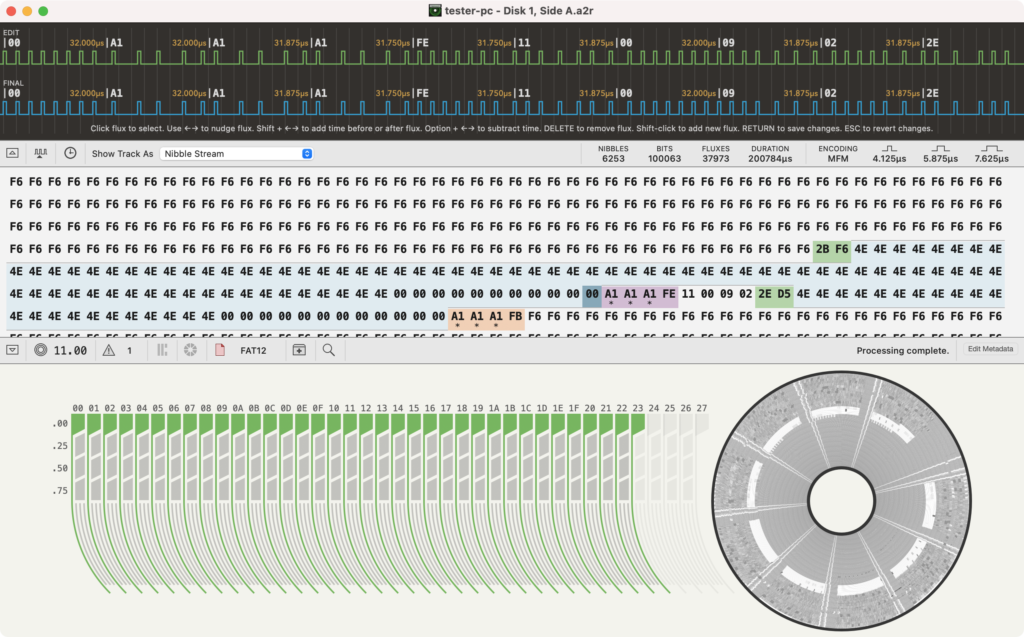
- The MC3470 test has been replaced by new Drive Analog Characteristics. These new tests give much more detailed information about how the read head and amplifier circuit are functioning.
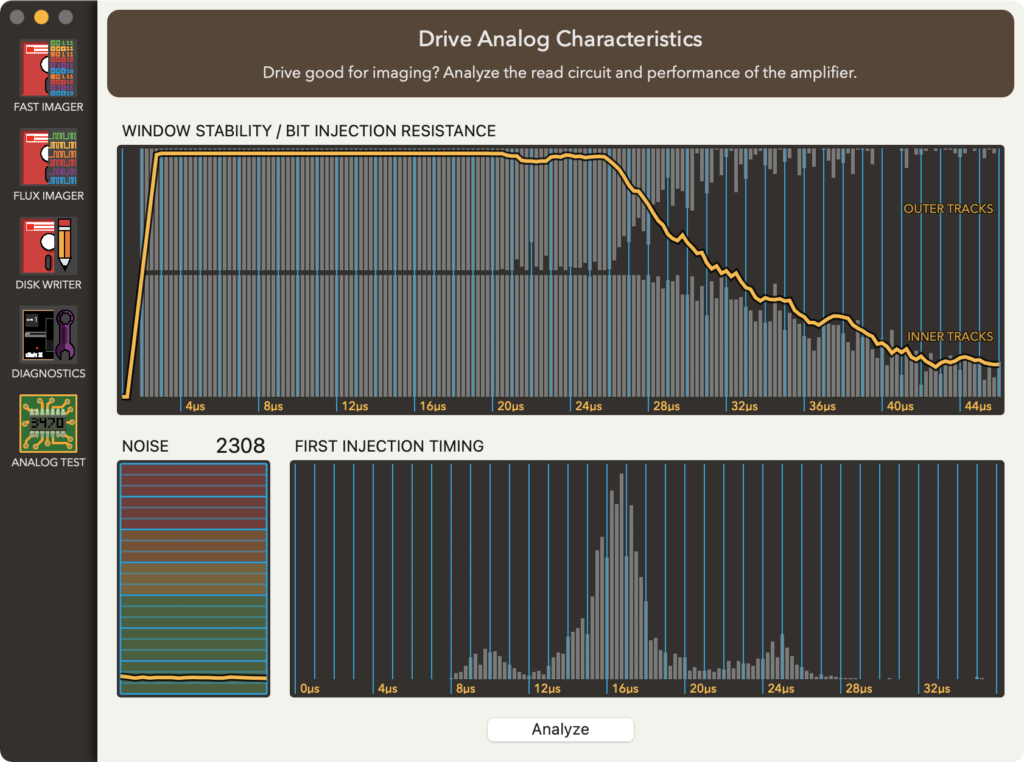
- The programming language Forth used a novel approach to disk storage. No files. It just stored source code directly on disk in 1K chunks known as Forth Blocks or Screens. And depending on what system you were programming, the arrangement of these Forth Block differed from other systems. So, without the original Forth software it can be very difficult to recover this data. A new Forth Blocks tool has been added to the Disk Analyzer (under the Tools menu). This will attempt to find Forth Blocks by automatically determining how they are arranged, screen sizes, sector interleaves, and other esoteric things. It will then let you browse the resulting source code as well as save it to a text file.
- Supports loading Mac disks from .img (raw sectors with no structure) files.
- Added an Eject Disk item to the Tools menu. This will allow you to eject 3.5 disks.
- Flux Imager 3.5 now provides the option to force it to image both sides of a disk even if it is a single-sided disk.
- When saving as a WOZ file, the Fast Imagers will now indicate in the metadata that the disk was created via fast imaging.
- Added ability to edit the apple2_requires metadata from within the Metadata Editor for WOZ files.
- Fixed: Fast Imager 3.5 didn’t reset the block status after stopping a Retry Bad operation.
- Disk Writer 3.5 will now wipe the back side of a disk when writing a single-sided image.
- Fixed: CBMDOS disks with a recursive directory could hang the Disk Analyzer.
- Fixed: When loading WOZ v1 files and then exporting as WOZ v2, it was not generating all WOZ data for updated version (bit rate, etc).
- Fixed: Apple DOS disks that contained no files were not being properly identified as Apple DOS.
- Allow Apple II CP/M disk to be exported in WOZ format.
- Minor cleanup to UX and performance of Go command in Disk Analyzer.
- There is more good stuff that happened in this release, but I did a poor job of writing notes as I worked.
Release 1.45
Lots of improvements have been made to the Disk Analyzer to make the exploration of disk images easier with more power at your fingertips. Also took a bit of a jaunt into the world of Atari 8-bit disks.
- Rebuilt the Logical Block view in the Disk Analyzer. It now displays things like the filename and purpose of the sector if known. The arrows on the right side of the block header can be used to jump to the previous and next block of the file.
- New Go… command (under the Analysis menu) will let you jump to anywhere on the disk. There is a optimized Go screen for each of the Nibbles, Physical Sectors, and Logical Blocks views. The Logical Blocks view also shows a list of Bookmaks for common disk structures like directories in order to make them easier to inspect.
- When viewing a file from the Disk Analyzer, you now have the option to save the file. This will let you save individual files from disk images. You not only can save the file, but if Applesauce understands the format of the file then it can also convert the file. You can output a program listing of an Applesoft file instead of just the binary data. It can also convert text files to modern UTF8 text files. If you are interested in Mac resources, you can export a resource fork as a resource file, or even have it extract all of the individual resources and save as separate files.
- Improved support for Atari 8-bit disks. Fast Imaging of single, enhanced, and double densities should now be working properly. Better recognition of disks eligible for saving into ATR format as well.
- Improved the display performance of the Disk Analyzer.
- Fast Imager eligible save format lists now allow more options based on disk geometry.
- More performant handling of empty sectors for Apple DOS 3.2 and earlier.
- Physical Sectors view was not always showing the correct epilogue markers. Fixed.
- When using the Files view in the Disk Analyzer, you can now press the Return key to open the currently sected file. The sector map on the left side of the pane can also be clicked to jump to a logical block.
- Improved support for 800K MFS and Lisa Monitor disks.
- Changed Find in Files to require double-clicking file to open instead of just selecting it.
- Metadata Editor wasn’t properly reflecting the Mac color depth setting. Fixed.
- Fixed visual glitch where exporting a disk in DSK, DO, and PO format would sometimes show more bad sectors than actually existed.
- Fixed various crashes and cleaned up some small UI bits.
Searching for client release 1.44
The theme of this release is Searching.
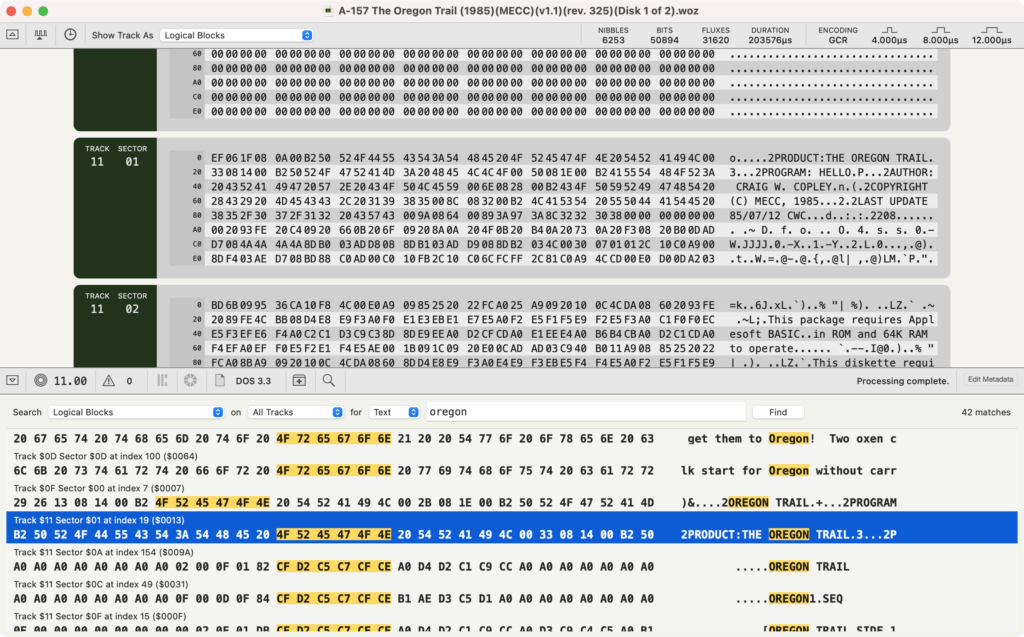
A new Find command has been added to the Disk Analyzer. It will allow you to search Nibble Streams, Sectors, Blocks, and Files for Hex or Text strings. The Hex search also supports wildcards by replacing any nybble with a ? character (ex: D5 A? 96) Text search is case insensitive and supports Apple II high bit characters. For nibble searches, you can add a + character to require that hidden timing bits must exist after the nibble. (ex: FF+D5) It also allows you to search for desynchronized nibbles.
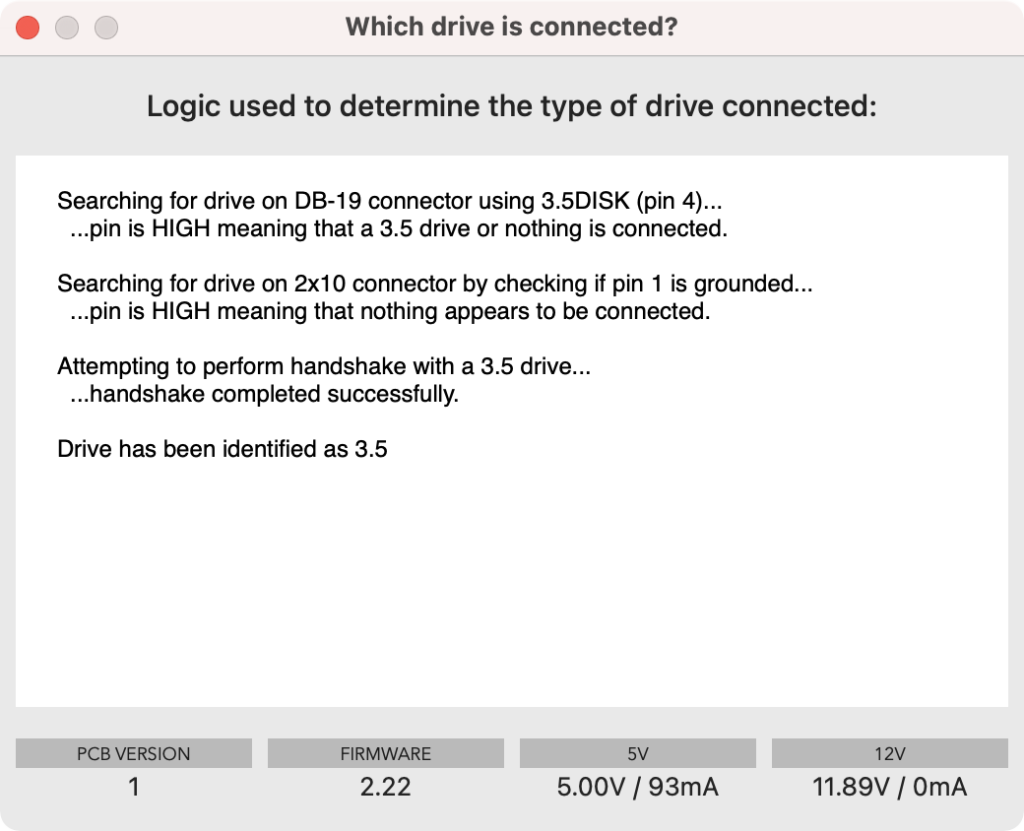
If you are having issues with a drive not being properly detected, there is a new “Which drive is connected?” item in the Help menu. It will show logs for the detection process that Applesauce used. Hopefully it will help people more easily discover why a drive fails to connect.
Firmware update to add support for more Apple SuperDrive 3.5 models.
Client Release 1.43
This release is mainly cleanup of the current bug list. Please watch your step, lots of squashed bugs around here. Maybe a new feature or two as well.
- Added file system support for Lisa Monitor.
- Preliminary support for loading DiscFerret DFI images for single-sided 5.25 disks.
- Improved geometry calculations for disks that lie about sector numbers.
- Improved data repair by looking at more neighboring tracks.
- Fixed: Flux Imager saving could sometimes encounter errors when saving as illegal filenames, and then it won’t let you save at all.
- Better filtering of illegal volume names on FAT12 disks.
- Fixed: Disk Analyzer wasn’t properly enabling the Save function after a metadata edit.
- Fixed: The Commodore Load string metadata wasn’t properly displaying in the metadata editor.
- Enable Compare/Repair button in Disk Analyzer only if a disk has valid geometry.
- Cleaned up 5.25 Diagnostics tests.
- Fixed: Disk Writer 3.5 would ALWAYS sync a disk if a sync sensor was found. It will now respect the Force Sync checkbox.
- Fixed: Exporting an oddball 800K MFS disk now works properly.
- The usual cleanup of small UI issues and bug fixes.
Client Release 1.42.1
I’m finally getting settled in some new digs and once again have some office space to get coding done. I’ve been able to carve out a bit of time to knock some tasks from my todo list for Applesauce. One of the bigger items that has been on the list for quite a while is writing to 3.5″ HD (1.44MB) disks. I’m happy to report that it is now completed! It will of course require that you are using an Apple SuperDrive (or a Sony MFD-75W-01G mechanism from a Mac stuffed into the normal 800K enclosure).
Anyway, here are the release notes for v1.42.1:
- Lots of UI cleanup work to Disk Writer 3.5.
- Ability to write 1.44MB 3.5″ disks.
- Lots of UI cleanup in Disk Analyzer, like fixing cut off log messages.
- Improved contrast in hex view of disk comparisons.
- Changing platform tab in Metadata Editor didn’t correctly allow you to save. Fixed.
- Improved detection of Lock-It-Up copy protection.
- Improved detection of Atari and Commodore disks when exporting/saving.
- Vastly improved loading/analysis/export of many EDD files.
- Fixed an issue with WOZ 1.0 loading that prevented exporting to other formats.
- Fixed crash when dealing with Apple Pascal files that are zero blocks long (illegal).
- Fixed issue with saving A2R files after editing metadata.
- Fixed crash when loading some malformed WOZ files.
- This release underwent a significant amount of refactoring internally.
I also noticed that I didn’t make a post here about v1.41. There was some good stuff in that release as well:
- The Disk Analyzer can now perform sector-level comparisons of disk images. And if the disks are using a file system that Applesauce recognizes, then it will also allow file-level comparisons. Have 2 images of the same product and want to know if they are the same? This will quickly tell you.
- Added support for loading IMG files of FAT disks. Loading of DiskCopy 4.2 images with an IMG extension also now supported.
- Better handling of write protected disks during the Check Drive function in Diagnostics.
- Fixed an issue where loading WOZ files with an unknown file system would incorrectly export to a sector-based disk format like DSK, DO, PO, etc.
The client can be downloaded from here.
Lots more new features are on the way! Stay tuned!
